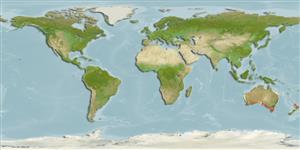>
Gobiiformes (Gobies) >
Gobiidae (Gobies) > Gobiinae
Etymology: Arenigobius: Latin, arena, harena, -ae = sand + Greek, kobios or Latin gobius = gudgeon (Ref. 45335).
More on author: Günther.
Environment: milieu / climate zone / depth range / distribution range
Ekologi
laut; payau dasar (demersal). Temperate
Western Pacific: eastern and southern Australia.
Size / Weight / umur
Maturity: Lm ? range ? - ? cm
Max length : 11.0 cm TL jantan/; (Ref. 9002)
Facultative air-breathing in the genus (Ref. 126274); Found in upper estuaries, in seagrass beds, and mangroves (Ref. 9002); inhabits burrows (Ref. 75154).
Life cycle and mating behavior
Kematangan | Reproduksi, perkembang biakan | Pemijahan | telur-telur | Fecundity | Larva
Kuiter, R.H., 1993. Coastal fishes of south-eastern Australia. University of Hawaii Press. Honolulu, Hawaii. 437 p. (Ref. 9002)
Status IUCN Red List (Ref. 130435: Version 2024-1)
ancaman kepada manusia
Harmless
penggunaan manusia
Alat, peralatan
laporan khas
muat turun XML
Sumber internet
Estimates based on models
Preferred temperature (Ref.
123201): 15.1 - 24.7, mean 18.2 °C (based on 142 cells).
Phylogenetic diversity index (Ref.
82804): PD
50 = 0.6250 [Uniqueness, from 0.5 = low to 2.0 = high].
Bayesian length-weight: a=0.00955 (0.00355 - 0.02566), b=3.03 (2.80 - 3.26), in cm total length, based on LWR estimates for this (Sub)family-body shape (Ref.
93245).
Trophic level (Ref.
69278): 3.3 ±0.4 se; based on size and trophs of closest relatives
Daya lenting (Ref.
120179): Tinggi, Waktu penggandaan populasi minimum kurang dari 15 bulan (Preliminary K or Fecundity.).
Fishing Vulnerability (Ref.
59153): Low vulnerability (10 of 100).
Nutrients (Ref.
124155): Calcium = 143 [58, 418] mg/100g; Iron = 0.5 [0.2, 1.1] mg/100g; Protein = 17.9 [15.9, 19.8] %; Omega3 = 0.298 [0.102, 0.795] g/100g; Selenium = 4.19 [1.51, 12.02] μg/100g; VitaminA = 22.5 [5.4, 93.4] μg/100g; Zinc = 1.25 [0.75, 2.05] mg/100g (wet weight);
